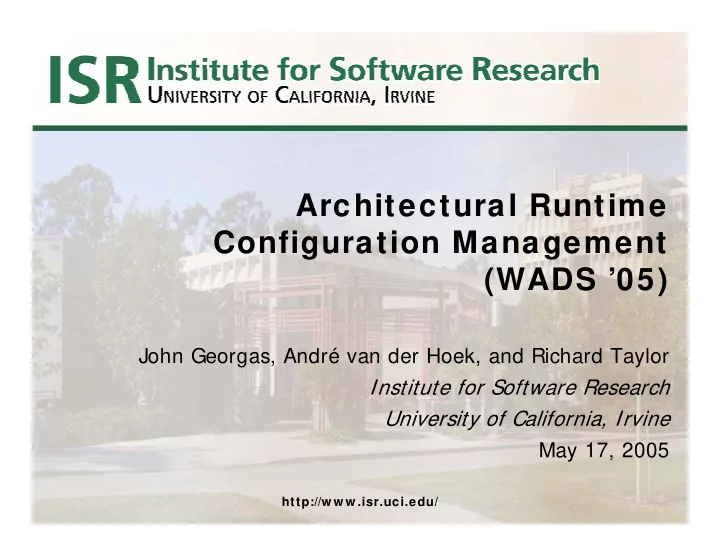

Architectural Runtime Configuration Management (WADS ’05) John Georgas, André van der Hoek, and Richard Taylor Institute for Software Research University of California, Irvine May 17, 2005 http://w w w .isr.uci.edu/
http://www.isr.uci.edu/ Background: Self-Adaptive Systems � Systems which autonomously adapt.
http://www.isr.uci.edu/ Background: Fundamental Assumptions � Explicit architectural models: � Evolution and adaptation through these models. � Out of scope: � Decision-making processes guiding adaptations. � State restoration and/or transfer. � Quiescence before modifications. � Architectural invariants throughout adaptation.
http://www.isr.uci.edu/ Motivation � Low visibility and independent nature of self- adaptive systems diminish trust in the adaptation process. � Opaque adaptation processes. � Behavioral changes only adaptation indicators. � Dynamic self-adaptive systems can change in unpredictable ways. � Dynamic policy-based systems. � Perceived dependability of the adaptation process.
http://www.isr.uci.edu/ Approach � Architectural Runtime Configuration Management (ARCM) � Key Features: � Runtime monitoring of architecture-based self- adaptive systems. � Maintaining a runtime configuration version graph. � Graphical visualization of version information. � Operations for user-driven fault recovery .
http://www.isr.uci.edu/ Research Vision: Increasing Visibility � Configuration version graph indicating adaptations. � Cycles, but no loops. � Single edge between configurations; anti-parallel. � Links to policies which cause adaptation.
http://www.isr.uci.edu/ Research Vision: Increasing Visibility, continued � Adaptation awareness: � Explicit recording of any adaptations in a configuration graph. � Generated at runtime, as changes take place. � Adaptation history throughout system lifetime. � Graphical visualization of the configuration graph: � Intuitive and easy to understand artifact. � Enhanced visibility: � Reduces the opaque nature of adaptation process. � Allows additional questions about systems. � Increases trust in the adaptation process.
http://www.isr.uci.edu/ Research Vision: Recovery Operations � Potentially undesirable adaptations necessitate recovery facilities. � Desirability determined by architect. � Recovery Operations: � Rollforward � Transition in the direction of a graph edge. � Rollback � Transition against the direction of a graph edge. � Out- and in-degree > 1 require user selection. � These operations provide for user intervention into the self- adaptive process. � Leveraging architect expertise.
http://www.isr.uci.edu/ Prototype Tool Support: ARCM Driver � Integrated into the ArchStudio development environment. � Observes and monitors systems for runtime adaptations. � Builds configuration version graph: � Records pre- and post-adaptation configuration. � Stores bi-directional diff files. � Provides graphical visualization of the version graph. � Recovery operations: � Merges graph’s diff information for operation enactment. � Diffing and merging facilities already present. � System architecture is evolved by AEM.
http://www.isr.uci.edu/ Prototype Tool Support: ARCM Driver Screen Capture
http://www.isr.uci.edu/ Prototype Tool Support: Under Development � Refined implementation: � Transition to xADL schema for graph data (XML-based). � Enhanced graphs with support for multiple branching. � Identification of duplicate nodes. � Architectural configuration hashing. � Arbitrary graph transitions. � Allows for multi-step recovery operations. � Diff composition. � Better visualizations: � Integration with Archipelago, the ArchStudio visual editor. � Graph layout with DOT.
http://www.isr.uci.edu/ Prototype Tool Support: Just in…
http://www.isr.uci.edu/ Future Research Directions � Further graph annotations: � Rejected configurations with counts. � Time spent in each configuration. � Explore automated detection of desirability. � Architectural configuration patterns. � Closer integration with adaptation process: � Use recovery operations as an active reflection layer. � Include recovery operations into adaptation management decision- making for automated invocation. � Leverage graph information in decision-making processes.
http://www.isr.uci.edu/ Conclusion � ARCM: � Maintains a record of adaptation history. � Enhances the visibility of adaptations. � Provides user-driven fault-recovery facilities. � Increases in perceived dependability through increased visibility and transparency of the adaptation process. � Fully decoupled from specific adaptation management and enactment methods. � Under active development; a new, fully-featured version is expected to be released soon.
Recommend
More recommend